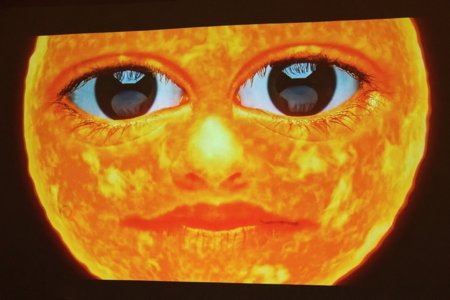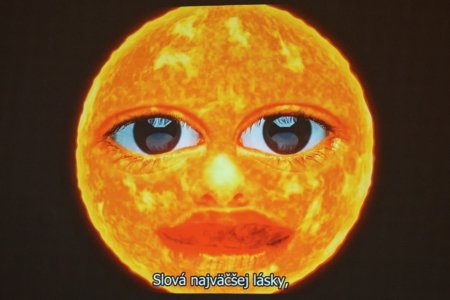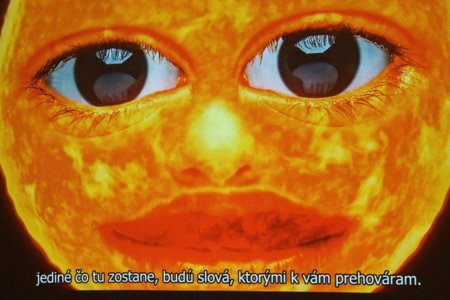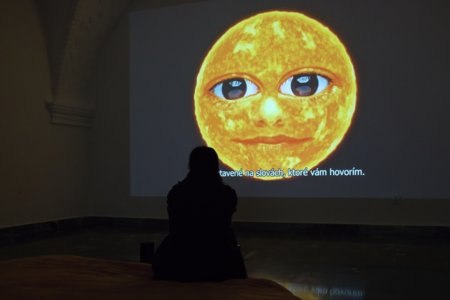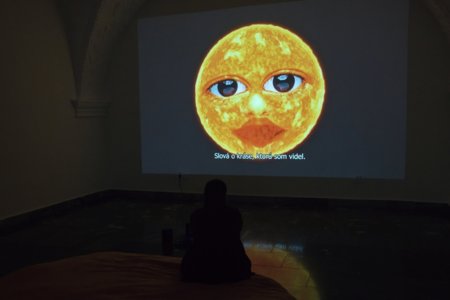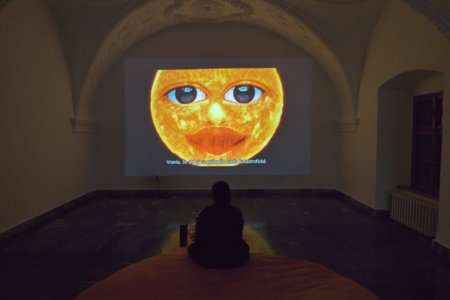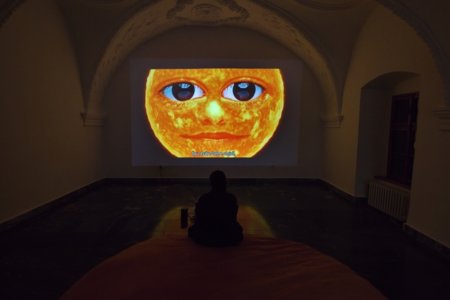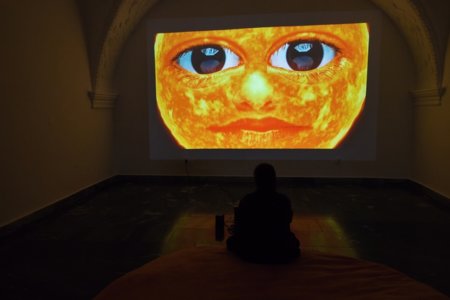Agnieszka Polska: The New Sun
Stucco Hall
Curator: Mária Janušová
Implementation team: Silvia Herianová, Katarína Jankechová, Miloš Janovský, Božena Výbochová
Translation: Silvia Herianová
Subtitles: Kerem Basaran, Mária Janušová
Duration of exhibition: 18 Dec 2021 – 4 Dec 2022
Location: Stucco Hall, Jozef Kollár Gallery, Nám. Sv. Trojice 8, Banská Štiavnica
Organizer: Slovak Mining Museum, Banská Štiavnica
We feel honoured to have the opportunity to present the famous video artwork The New Sun (2017) by Agnieszka Polska, a contemporary Polish visual artist, in the Jozef Kollár Gallery. This more than 12-minute-long digital animation has been presented in a number of world-renowned galleries, and this is the first time it can be viewed in Slovakia. Our gratitude goes to the artist for her trust and to the Goethe Institute, Bratislava, for its financial support of the project. The video conveys a powerful ecological message and aligns perfectly with the green strategy pursued by our institution.
The New Sun was originally part of a video-diptych, for which the artist found motivation in a poem for children (Co słonko widziało / What the Sun Has Seen) written by Maria Konopnicka (1842 – 1910). Her poem reflects on the Sun observing the planet Earth and the every-day life of a farmer. In the Jozef Kollár Gallery, we are presenting the first of Agnieszka’s two videos since the second one, What the Sun Has Seen, is a kind of follow-up that explains the first. The multi-media installation in the Gallery’s Stucco Hall, therefore, offers a more metaphoric message, one that is not completely explicated, thus offering greater space for imagination and interpretation.
The work consists of a digital animation with the Sun as the main character. It is presented as a blazing orange circle with a human face. The Sun has large almond-shaped brown eyes, a small nose and red lips. These features remind us of a small child. Its piercing eyes are fixed on us, and its voice is strange, sounding somewhere between adolescent and adult, masculine and feminine. The Sun’s words do not make much sense to us. Its speech and appearance are whimsical, too: it occasionally sings, and other times jokes; once it comes closer, and then it departs from us. Consequently, we might ask ourselves, “What the hell is it going on here?!”
Despite our initial lack of understanding of this bizarre creature, we are somehow not able to turn our eyes from it. Perhaps it is because of the Sun’s examining gaze or its radiant colour, which is in sharp contrast with the black background. The Sun majestically dominates the eternally dark framework. We carefully watch its large melancholic eyes and their slow winking, the lips moving, and hear the dynamically changing voice. We notice that speech alternates with singing, whispering, shouting and laughter. The words are being repeated and lost in an uncertain emptiness. The slow rhythm accelerates, and then slows again. Gradually, the Sun’s monologue captivates us, gets under our skin, until we are completely subdued. Suddenly, it all begins to make sense.
We see the Sun amidst cosmic eternity, speaking to us as the human community and sharing its observations of the Earth. Despite the enormous distance and watching from above, the Sun has detailed information about us. Everything is happening “under its gaze”. We are those who have “cheeks covered in scars”, “bruised arms and broken wrist”. The Sun is a witness to the current climate crisis, the devastation of our planet, and the approaching catastrophe. Despite the destruction that humankind inflicts on the Earth, the Sun, surprisingly, expresses its love for us, even calls us “baby”. However, it can only observe us; when it comes to our tragic fate, it is completely helpless. As it says, “We do not share the same temporality”. Although it does not need to care about us, the Sun expresses its kindness and compassion for us. It comforts us, jokes about the climate change, and sings a gospel or a musical song. It tries to soothe us by saying that if everything disappears, there will be words that remain. In the Sun’s view, these will be the words that speak about love, tolerance and equality among people. They will establish a new order in the world.
Immediately after seeing the video-installation, we may have mixed feelings. These might be caused by the fact that the scary motif of the climatic catastrophe, which is not far from being a reality, is presented in a moderated way; there are jokes told about it, or the motif is softened by a sweet narrative. The words about the horrendous fate alternate with jokes and expressions of love, dystopia with utopia, death with hope, rational with emotional. In addition to presenting clear opposites, the storyline is interwoven with serious social-political problems and scientific theories, combined with jolly singing, care-free stand-up comedy, and declarations of romantic love.
In the animation, there are several references to quantum physics. At the very beginning, we hear the following statement: “This film is about an observer that influences events through the act of observation.” According to quantum theory, observation has an effect on the observed system which, after being observed, collapses. After the collapse, however, the system can begin developing again. We can see a clear parallel between this theory of observation and the digital narrative. The Sun is presented as the observer, and its act of observing the Earth is followed by the destruction of the human life system. Fortunately, there is always hope and faith in a new beginning.
With its helplessness, the Sun can evoke in us the notion of “the angel of history” described by the German theoretician Walter Benjamin, as a result of his interpreting the artwork Angelus Novus (1920), by Paul Klee. According to Benjamin, “the angel looks as though he is about to move away from something he is fixedly contemplating. His eyes are staring, his mouth is open, his wings are spread. This is how one pictures the angel of history. His face is turned toward the past. Where we perceive a chain of events, he sees one single catastrophe which keeps piling wreckage upon wreckage and hurling it down at his feet. The angel would like to stay, awaken the dead, and make whole what has been smashed. But a storm is blowing from Paradise; it has got caught in his wings with such violence that the angel can no longer close them. The storm irresistibly propels him into the future to which his back is turned, while the pile of debris before him grows skyward. This storm is what we call progress.” Something like the Sun, Benjamin’s angel cannot fight against fate. Instead of moving forward, toward the vision of progress, he would rather stop and find peace with the past. However, the storm is propelling him ahead, and he is helpless in the face of this force. In this way, Benjamin highlights the significance of reflecting on and learning from history as well as remedying past errors and injustices.
Agnieszka Polska’s video-installation in the Jozef Kollár Gallery’s Stucco Hall has an unusually absorbing effect on us. We, however, need to be open recipients of impulses, succumb to the seen and heard, and allow art to influence us. In addition, Agnieszka’s artwork employs several of the viewer’s senses at the same time. Through a large projected image, dynamic music, and the Sun’s lyrical, lonely speech, the video-animation offers the unique experience of being drawn right into the film’s plot. From quite a close distance, you can look directly into the anthropomorphic Sun’s gigantic eyes and engage in an intimate discussion with it, as with an old friend or a lover, resulting in an intensive artistic experience. And, if you find yourself completely alone in the exhibition hall, the experience is even stronger.
The video purposefully manipulates us through the digital imaging techniques the artist has employed. The character of the Sun appears to be hypnotising or magical; it is hard not to look at it. The artwork conveys an alarming testimony to the approaching climate, as well as human, apocalypse. The addressee of this urgent appeal is us, the human community. If we do not do everything possible to protect our planet, we cannot avoid the catastrophe. The visual essay The New Sun, therefore, challenges us to act, not to remain ignorant but, instead, to become fully aware of our social and moral responsibility for the future of life on Earth.
Agnieszka Polska (*1985, PL) is a visual artist working mainly with digital media, animations, film, photographs and installations. She studied at the Academy of Fine Arts in Krakow and at the Art Academy in Berlin. Her artwork has been exhibited in prestigious institutions around the world, for example, the New Museum and MoMA in New York, the Tate Modern in London, Center Pompidou in Paris and Hamburger Bahnhof in Berlin. For the two videos The New Sun and What the Sun Has Seen, Agnieszka Polska received the German Preis der Nationalgalerie in 2017. She lives and works in Berlin.
Text: Mária Janušová
Exhibition Partners: Goethe Institut and Svetro, s.r.o.
Photo by: Beata Babiaková, Lubomír Lužina
Excerpt from Agnieszka Polska´s video: https://www.youtube.com/watch?

